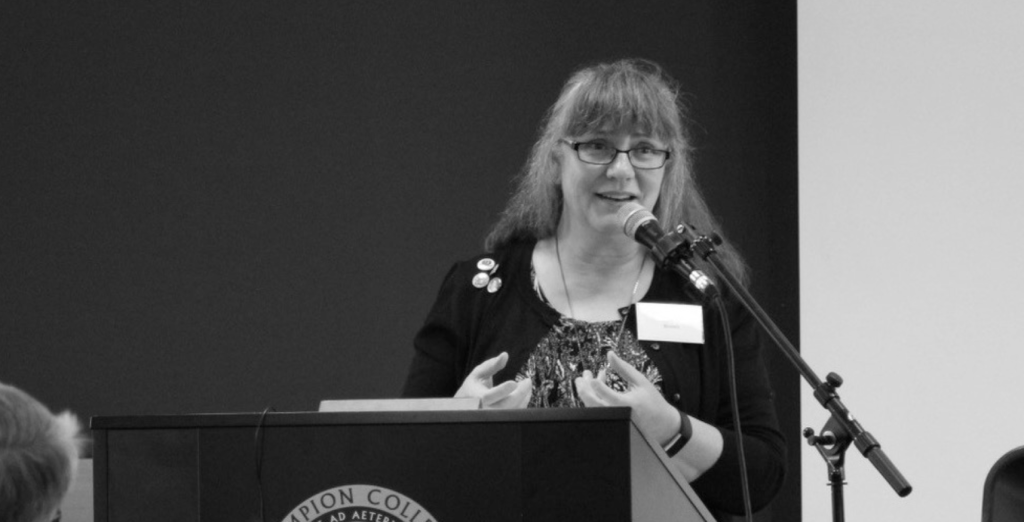
In recent years Nancy Brown, a prominent member of The Society of Gilbert Keith Chesterton in America and the biographer of Chesterton’s wife, Frances, has published two children’s books incorporating Gilbert and Frances as characters. Gary Furnell reviews the two books, and highlights how they illustrate the special value of children’s literature.
Nancy Brown has multiple non-fiction books to her credit, including The Woman Who Was Chesterton (2015), an excellent biography of Frances Chesterton, Gilbert’s beloved wife, and G.K. Chesterton and Our Lady: Readings and Essays on Chesterton’s Spiritual Life (2022).
Nancy has also written two adaptations of Father Brown stories for children. Her first original chapter book for 8-10-year-olds was The Chestertons and the Golden Key (2016). There is now a worthy sequel, The Chestertons and the
Top Meadow Troupe (2023), aimed at 10-14-year-old readers.

Top Meadow Troupe (2023)

Both books are beautiful; they are high-quality publications. Each page has a frame around the text and subtle ornamental details abound, giving a sense of careful attention to presentation. In addition to colourful cover art, illustrator
Ann Kissane Engelhart has augmented the story with frequent drawings to help younger readers visualise the characters and their context.
There’s nothing blandly utilitarian in the production. This focused creativity reflects the stories which feature artistic efforts in the form of puppet plays, music, poetry, baking, handicrafts, home theatrics and story-writing.
Although the stories are imagined, the novels are based on real people — the
Chestertons and the Nicholl family — in real settings: the small towns of Lyme Regis and Beaconsfield in England during the 1920s.
In The Chestertons and the Golden Key — the first, slimmer novel (130 pages)—Gilbert and Frances, middle-aged, enjoying Gilbert’s success as a writer, holiday at the coast in Lyme Regis. They meet a local family, the Nicholls: three girls and their widowed mother live in a seaside cottage. The girls, aged 8, 10 and 11, are lively and excited by the dreams of achievement for the years ahead.
The Nicholls befriend the Chestertons. The Nicholl girls and their lonely mother enjoy the humour, solicitude and imagination of the Chestertons, while Frances and Gilbert delight in the Nicholl’s friendly vivacity. Two local boys and the Nicholl’s thieving dog provide the necessary degree of story-propelling tension and intrigue.
Characters triumphing over difficulties
Nancy Brown knows that the best children’s stories present their characters with difficulties to help young readers understand that difficulties can be overcome. Good stories also suggest the attitudes and strategies that aid this
triumph. In The Chestertons and the Golden Key, it becomes evident that Gilbert and Frances have overcome the grief and disappointment of childlessness. They coped with this sadness by cultivating loving relationships with their nieces, nephews, and the children of their many friends.
The Nicholl family must cope with the death of their husband and father. Mrs Nicholl struggles with bereavement; she neglects family enjoyments that once brought pleasure. Her grief impacts her daughters but she finds a modest liberation from her sadness by the story’s end which centres on music and a puppet play. The Chestertons are central to this evening of song and theatre, while cheerful neighbours are the audience.
The longer sequel, The Chestertons and the Top Meadow Troupe, (243 pages) is set the following Christmas time. The Nicholl family holiday at Beaconsfield where the Chestertons have their home, Top Meadow.
Again, there are mysteries for the girls to solve: who is sending their mother frequent letters? Who are the comatose men, recently injured in a shipping
disaster, cared for by nuns in Beaconsfield’s small convalescent home?
There are also difficulties for the girls to overcome: the proximity of a rude girl in the Chesterton’s circle; the alarming possibility of change as a man courts Mrs Nicholl; and the frustrating effort required to write a coherent story suitable for publication in a girls’ magazine.
The girls enjoy the company of Chesterton’s young cousin, spending his school holidays at Beaconsfield. The good-natured lad is a talented mimic, adept at imitating the voices of Aunty Frances and Uncle Gilbert. Their household is rich
with playful pranks, good sense, many pets, and lots of food.
Although the Nicholl girls are the main characters in both books, boys are likely to enjoy the stories because there’s more than enough adventure and comedy to engage their interest. The stories are well-paced and the style reveals a delight in language.
There’s a quiet emphasis on kindness, realism and artistic endeavour, even though misunderstanding and tragedy may temporarily darken our days. Religious adherence is portrayed as natural and good, and this is achieved
without intrusive authorial pronouncements. It’s a shrewd strategy. Christmas services are attended, a nativity scene adorns the Chesterton’s living room, and the presence of French nuns is an accepted part of the suburban setting.
The small mysteries in the stories are resolved, but there’s the sense that the ultimate mysteries of life will—thankfully—persist.
Nancy Brown’s children’s books combine readability, imagination, and child-scaled but real drama with the values that Frances and Gilbert Chesterton embodied: humour, hospitality and creativity.
The books would be excellent birthday, Confirmation or Christmas gifts, worthwhile additions to any library, and valuable home-schooling resources.
